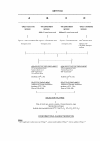An optimised recovery method for thermophilic Campylobacter from liver
- PMID: 11741507
- PMCID: PMC61043
- DOI: 10.1186/1471-2180-1-32
An optimised recovery method for thermophilic Campylobacter from liver
Abstract
Background: The past three decades have witnessed the rise of Campylobacter enteritis in man from virtual obscurity to notoriety, with present isolation rates superseding those of other enteric pathogens such as Salmonella spp. and Shigella spp. in most developed countries. Although campylobacters are not completely new to applied bacteriology, they have evaded traditional isolation techniques used for the isolation of pure cultures, apart from single isolations that were free from competing organisms. Offals, in particular liver have been described as both a source of campylobacters, as well as a route of transmission of this organism to human. Therefore, the aim of this study was to develop an optimum method for the recovery of Campylobacter spp. from porcine liver.
Results: Four isolation techniques (methods A-D) were compared in a small pilot study for their ability to successfully recover campylobacters from freshly eviscerated porcine liver. The optimum isolation method involved direct swabbing of the liver tissues followed by plating onto Preston Selective medium, which was superior to methods involving mechanical disruption to liver tissues, including direct plating and enrichment methods, with and without blood. Consequently, any isolation method that involves disruption of liver tissue e.g. homogenisation or stomaching, is not suitable for the detection of campylobacters from liver and hence it is recommended that employment of a direct swabbing technique without mechanical disruption of tissues in combination with selective plating to optimally recover campylobacters from freshly eviscerated liver.
Conclusions: Employment of a direct swabbing technique in combination with selective plating allow Campylobacter spp. to be optimally recovered from freshly eviscerated liver and therefore this technique is recommended when examining liver for the presence of this organism.
Figures
Similar articles
-
Optimising recovery of Campylobacter spp. from the lower porcine gastrointestinal tract.J Microbiol Methods. 2000 Oct;42(2):115-9. doi: 10.1016/s0167-7012(00)00183-4. J Microbiol Methods. 2000. PMID: 11018267
-
A comparison of different culture methods for the recovery of Campylobacter species from pets.Zoonoses Public Health. 2009 Nov;56(9-10):490-5. doi: 10.1111/j.1863-2378.2008.01205.x. Epub 2009 Feb 12. Zoonoses Public Health. 2009. PMID: 19243565
-
A comparison of procedures for the isolation of campylobacters from seagull faeces.J Hyg (Lond). 1983 Dec;91(3):445-50. doi: 10.1017/s0022172400060484. J Hyg (Lond). 1983. PMID: 6663060 Free PMC article.
-
Isolation and typing methods for the epidemiologic investigation of thermotolerant campylobacters.Int Microbiol. 1999 Dec;2(4):217-26. Int Microbiol. 1999. PMID: 10943417 Review.
-
Campylobacter and fluoroquinolones: a bias data set?Environ Microbiol. 2003 Apr;5(4):219-30. doi: 10.1046/j.1462-2920.2003.00425.x. Environ Microbiol. 2003. PMID: 12662169 Review.
Cited by
-
Occurrence of Campylobacter in Faeces, Livers and Carcasses of Wild Boars Hunted in Tuscany (Italy) and Evaluation of MALDI-TOF MS for the Identification of Campylobacter Species.Foods. 2023 Feb 10;12(4):778. doi: 10.3390/foods12040778. Foods. 2023. PMID: 36832850 Free PMC article.
References
-
- Prescott JF, Bruin-Mosch CW. Carriage of Campylobacter jejuni in healthy and diarrheic animals. Am J Vet Res. 1981;42:164–165. - PubMed
-
- Moore JE, Madden RH. Occurrence of thermophilic Campylobacter spp. in porcine liver in Northern Ireland. J Food Prot. 1998;61:409–413. - PubMed
-
- Soonattrakul W, Andersen BR, Bryner JH. Raw liver as a possible source of Vibrio fetus septicemia in man. Am J Med Sci. 1971;261:245–249. - PubMed
Publication types
MeSH terms
LinkOut - more resources
Full Text Sources
Miscellaneous


